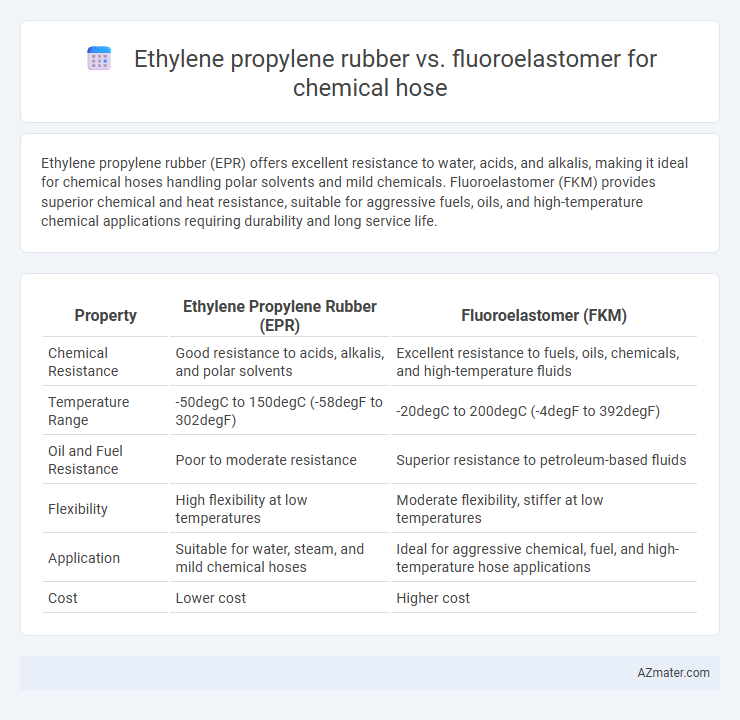Ethylene propylene rubber (EPR) offers excellent resistance to water, acids, and alkalis, making it ideal for chemical hoses handling polar solvents and mild chemicals. Fluoroelastomer (FKM) provides superior chemical and heat resistance, suitable for aggressive fuels, oils, and high-temperature chemical applications requiring durability and long service life.
Table of Comparison
| Property | Ethylene Propylene Rubber (EPR) | Fluoroelastomer (FKM) |
|---|---|---|
| Chemical Resistance | Good resistance to acids, alkalis, and polar solvents | Excellent resistance to fuels, oils, chemicals, and high-temperature fluids |
| Temperature Range | -50degC to 150degC (-58degF to 302degF) | -20degC to 200degC (-4degF to 392degF) |
| Oil and Fuel Resistance | Poor to moderate resistance | Superior resistance to petroleum-based fluids |
| Flexibility | High flexibility at low temperatures | Moderate flexibility, stiffer at low temperatures |
| Application | Suitable for water, steam, and mild chemical hoses | Ideal for aggressive chemical, fuel, and high-temperature hose applications |
| Cost | Lower cost | Higher cost |
Introduction to Chemical Hose Materials
Ethylene propylene rubber (EPR) and fluoroelastomer (FKM) are key materials used in chemical hoses, each offering distinct chemical resistance and temperature tolerance. EPR excels in handling alkaline substances and hot water at temperatures up to 130degC, making it suitable for versatile industrial applications. Fluoroelastomers demonstrate superior resistance to aggressive chemicals, hydrocarbons, and temperatures up to 200degC, providing enhanced durability in harsh environments.
Overview of Ethylene Propylene Rubber (EPR)
Ethylene Propylene Rubber (EPR) is a synthetic elastomer known for its excellent resistance to heat, ozone, and weathering, making it ideal for chemical hoses exposed to harsh environments. EPR offers superior flexibility and good chemical resistance to acids, alkalis, and various solvents, contributing to its durability in diverse industrial applications. Compared to Fluoroelastomer, EPR is generally more cost-effective while still providing reliable performance in medium-temperature and non-aggressive chemical transport scenarios.
Overview of Fluoroelastomer (FKM)
Fluoroelastomer (FKM) exhibits exceptional chemical resistance, making it ideal for chemical hose applications where aggressive oils, fuels, and solvents are present. Its superior temperature stability, typically ranging from -26degC to 204degC (-15degF to 400degF), outperforms Ethylene Propylene Rubber (EPR), which has a narrower operational temperature range. FKM's resistance to swelling, ozone, and oxidation ensures long service life in harsh industrial environments compared to EPR, which is more limited in chemical compatibility and heat resistance.
Chemical Resistance: EPR vs Fluoroelastomer
Ethylene propylene rubber (EPR) offers strong resistance to a wide range of chemicals such as acids, alkalis, and oxidizing agents, making it suitable for many general industrial applications. Fluoroelastomers exhibit superior chemical resistance against aggressive fuels, oils, solvents, and highly corrosive chemicals, outperforming EPR in environments with exposure to hydrocarbons and harsh chemicals. Fluoroelastomer hoses maintain integrity and performance under extreme chemical stress, providing longer service life in specialized chemical processing and petroleum industries compared to EPR.
Temperature Performance Comparison
Ethylene propylene rubber (EPR) offers effective temperature resistance generally ranging from -50degC to 130degC, making it suitable for moderate temperature chemical hose applications. Fluoroelastomer (FKM) significantly outperforms EPR with its temperature tolerance spanning from -26degC up to 204degC, providing superior stability and durability in high-temperature and aggressive chemical environments. Selecting FKM over EPR enhances hose lifespan and safety during exposure to extreme heat and corrosive substances.
Mechanical Properties and Flexibility
Ethylene propylene rubber (EPR) offers excellent flexibility and moderate mechanical strength, making it suitable for applications requiring frequent bending and moderate pressure resistance in chemical hoses. Fluoroelastomer (FKM) provides superior mechanical properties such as high tensile strength, abrasion resistance, and exceptional chemical resistance, but it tends to be less flexible and more rigid compared to EPR. The choice between EPR and FKM for chemical hoses depends on the balance needed between flexibility and durability under aggressive chemical exposure and mechanical stress.
Compatibility with Industrial Chemicals
Ethylene propylene rubber (EPR) offers excellent resistance to a wide range of chemicals, including acids, alkalis, and oxygenated solvents, making it suitable for many industrial chemical hose applications. Fluoroelastomer (FKM) exhibits superior compatibility with aggressive fuels, oils, and aromatic hydrocarbons, excelling in environments involving harsh chemicals and high temperatures. For applications requiring resistance to hydrocarbons and aggressive chemicals such as chlorinated solvents or brake fluids, fluoroelastomer hoses provide more reliable chemical compatibility and prolonged service life.
Cost Efficiency and Availability
Ethylene propylene rubber (EPR) offers superior cost efficiency for chemical hoses due to its lower raw material and manufacturing expenses compared to fluoroelastomers, making it ideal for budget-sensitive applications. Fluoroelastomers provide exceptional chemical and heat resistance but come with significantly higher costs and limited availability, often leading to longer lead times and supply challenges. EPR is widely available and versatile, making it a preferred choice for general chemical hose applications where moderate resistance is acceptable.
Typical Applications in Chemical Hoses
Ethylene propylene rubber (EPR) is commonly used in chemical hoses for applications involving water, acids, and alkalis due to its excellent resistance to heat, ozone, and weathering. Fluoroelastomer (FKM) is preferred in chemical hoses handling aggressive chemicals like hydrocarbons, oils, and solvents, offering superior chemical resistance and high-temperature stability. Both materials provide flexibility and durability, but FKM is typically chosen for more demanding chemical environments requiring enhanced resistance to harsh substances.
Choosing the Right Material for Your Needs
Ethylene propylene rubber (EPR) offers excellent resistance to heat, oxygen, and ozone, making it ideal for chemical hoses handling acids, alkalis, and water-based chemicals at moderate temperatures. Fluoroelastomer provides superior chemical resistance to a broader range of aggressive solvents, oils, and fuels, maintaining performance in high-temperature environments up to 200degC. Selecting the right material depends on chemical compatibility, temperature range, and application requirements to ensure optimal durability and safety for your chemical hose.

Infographic: Ethylene propylene rubber vs Fluoroelastomer for Chemical hose
 azmater.com
azmater.com